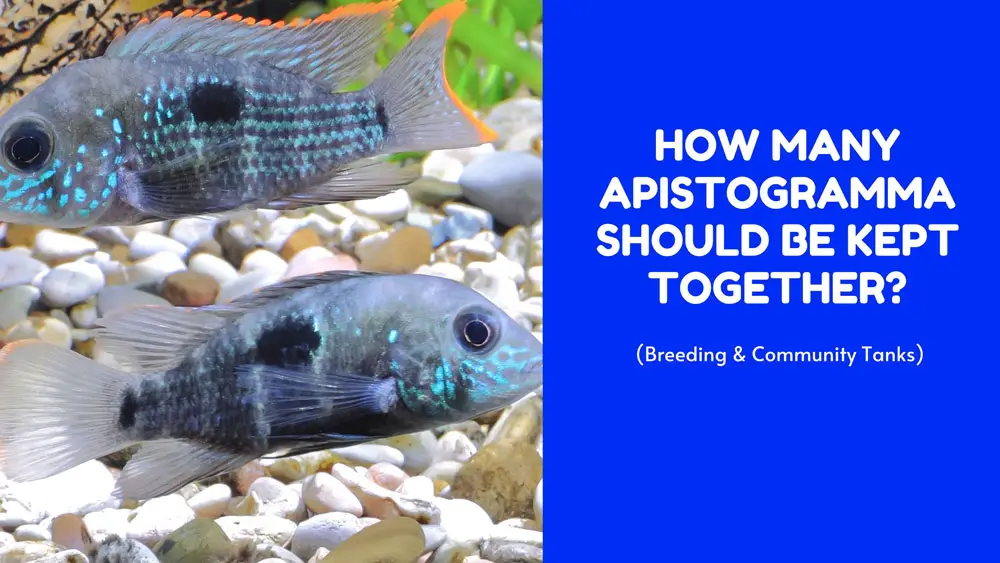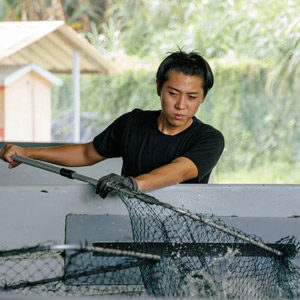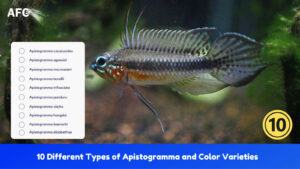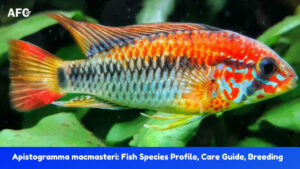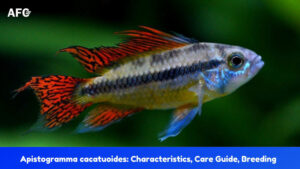One of the most common questions asked by new Apistogramma owners is, “How many Apistogramma can be kept in a 20-gallon or 55-gallon aquarium?” It’s a logical question, as most fish keepers who become interested in having these diminutive fish tend to have small- to medium-sized tanks.
But, it’s also a tough question to answer. Depending on the size of your aquarium, the species of Apistogramma you have, and what type of aquarium you are going to set up, you may have come across hundreds of opinions about how many fish can be safely housed together.
Luckily, as with anything, there is a very rough Rule of Thumb. Read on to learn the general recommendations and factors that will most impact your Apistogramma stocking levels.
Rule of Thumb
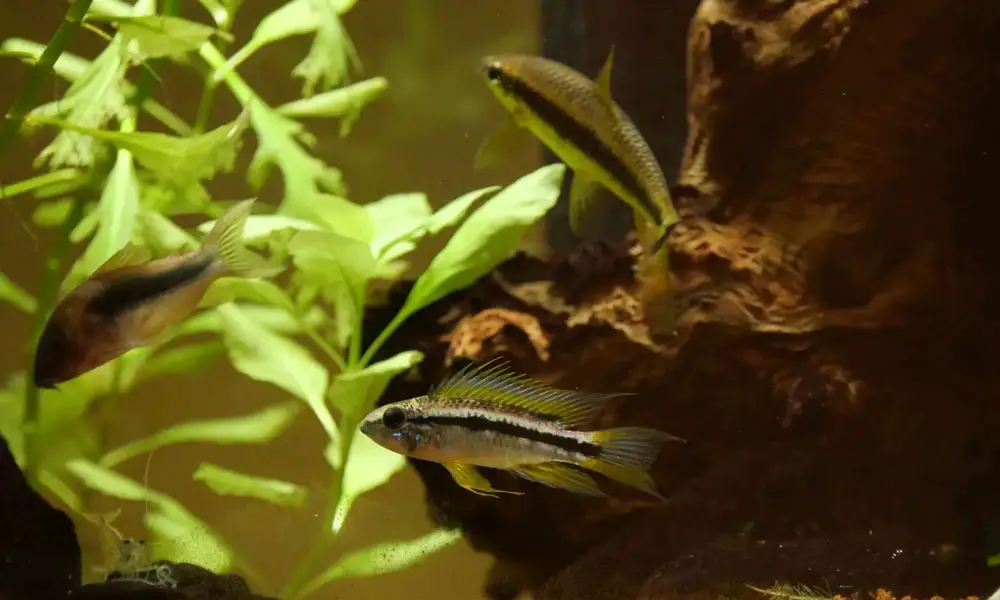
If you’ve had any exposure to the fish-keeping world, you may have heard the most widely-known rule for stocking a tank: one inch of fish per 1-2 gallons of water. While this rule applies well to other small community fish (3 inches or less), it does not apply to dwarf cichlids due to their aggressive and territorial nature.
Instead, an accepted “Rule of Thumb” in the Apistogramma hobby is that each fish should have a territory of approximately 12 inches (30 cm) in diameter.
This is a good starting point, but there are several factors to consider when stocking an Apistogramma tank before one can be sure that the fish will have enough space and territory in the bottom area.
How Many Apistogramma Can I Put in a Fish Tank?
Given their small size, this simple rule makes it much easier to calculate how many Apistogramma you can stock in your aquarium.
As you may guess, a wider tank is more suitable for keeping Apistogramma as it provides a larger footprint, allowing the fish to establish their own territory.
The chart below lists the most common aquarium sizes, their dimensions, a’s well as the number of Apistogramma that the aquarium can safely house within the recommended territory.
| Tank Size | Dimensions (L x W x H) | Number of Fish |
|---|---|---|
| 10-gallon (Breeding) | 20″ x 10″ x 12″ | A pair/trio |
| 15-gallon | 24″ x 12″ x 12″ | A pair |
| 20-gallon (long) | 30″ x 12″ x 12″ | A pair |
| 29-gallon | 30″ x 12″ x 18″ | A pair |
| 30-gallon (breeder) | 36″ x 18″ x 12″ | A pair/trio |
| 40-gallon (long) | 48″ x 12″ x 16″ | A harem of one male with 3 females |
| 55-gallon | 48″ x 13″ x 21″ | A harem of one male with 3 females |
| 75 gallon | 48″ x 18″ x 21″ | A harem of one male with 3 females |
| 125-gallon | 72″ x 18″ x 21″ | A harem of 2 males with 4 – 5 females |
Factors Affecting the Number of Apistogramma in a Tank
Once you get to the point where you want to stock more Apistogramma than the chart above would suggest, there are several factors that will come into play.
Aquarium Type
The two basic types of fish tanks in the Apistogramma world are community-type tanks and breeding tanks. Remember a community tank can never be used as a breeding tank.
A 10-gallon aquarium is the most commonly available tank and is both inexpensive and large enough to breed almost any Apistogramma species, whether it’s a breeder pair or a trio of one male and two females. Never keep more than one male in a 10-gallon spawning tank.
The stocking density in a community tank is a bit more complicated since various species of Apistogramma cichlids will have different temperaments, breeding practices, sizes, aggression levels, and living conditions.
Breeding Practices & Aggression Levels
When selecting an Apistogramma species for your community tank, choose carefully. Some species, such as Agassiz’s dwarf cichlid (A. agassizii), Three-Striped Apisto (A. trifasciata), and Banded Dwarf Cichlid (A. bitaeniata), are strictly polygamous and tend to be quite demanding and aggressive. Other species, like A. borellii and A. steindachneri, practice opportunistic polygamy, where the male will attempt to breed with any female as the opportunity arises, without any exclusivity.
When stocking these polygamous species, it is recommended to keep a harem of one male with at least two females. This ratio helps to ensure a more peaceful environment for the fish and reduces the male’s aggression, especially when a female is not ready to spawn.
Ensure each female has her own hiding spot and the room to establish and defend her territory. The less aggressive the species are, the more fish you can have.
Tank Mates & Preferred Tank Levels
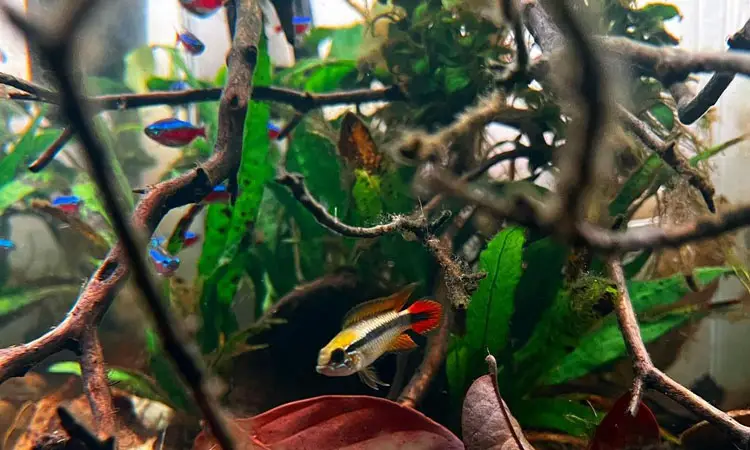
An attractive community tank of Apistogramma can be created by incorporating other peaceful and small fish species that prefer different water levels rather than competing for the same space. As a bonus, it gives you more room to raise more Apistos in the tank.
Since Apistos are known as bottom dwellers that stay primarily on the bottom of the tank, fishes that prefer the middle and top levels of the aquarium are ideal tank mates.
Good choices are Neon Tetras, Pencilfish, hatchet fish, and other small dither fish. Make sure to select tankmates that can tolerate similar water parameters as Apistogramma cichlids; otherwise, they may not do well in such an environment.
Aquascaping
Next, think about aquascaping. When starting out in aquascape design, the goal should be to create a natural landscape that closely mimics Apistogramma’s native habitat, rather than designing something that is merely aesthetically pleasing to you.
The design principles for aquascaping a tank used for Apistogramma should be based on providing lots of hiding spots and boundaries. A great way to do this is by adding necessary elements, such as live plants, driftwood, dead leaves, rocks, and caves, that provide the illusion of different levels in the tank.
Simplicity is your friend. Many aquarists tend to overdo it by adding too much in the tank, which can make it look cluttered and as well as make a difference in the amount of fish that can successfully be kept.
Keep in mind that some plants thrive in different conditions, and floating species are always appreciated by Apistogramma.
Last Words
Apistogramma are cichlids with very strict stocking densities. When stocking, stick to the general rule of providing them with abundant territory instead of the “One Inch per Gallon” rule of thumb.
Always research the species of Apistogramma that you are interested in prior to purchase, and never buy fish on impulse. Carefully select tank mates for your Apistos so that they have enough room to live and can co-exist peacefully.
Finally, don’t forget about aquascaping! Set up an attractive habitat with plenty of hiding spots and features that re-create their natural environment. This will give your Apistogramma cichlids a better chance for long-term success in the aquarium.
